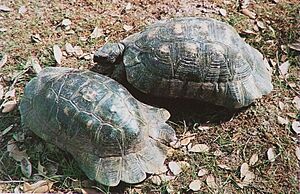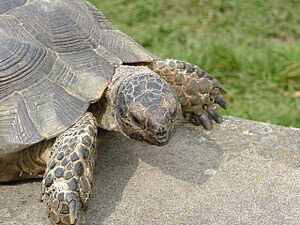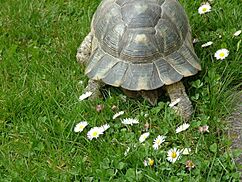Marginated tortoise facts for kids
The marginated tortoise (Testudo marginata) is a type of tortoise that belongs to the family called Testudinidae. These tortoises are found only in certain areas, mainly Greece, Italy, and the Balkans in Southern Europe. They are the biggest tortoises in Europe! Marginated tortoises eat only plants and spend the winter in a special sleep called brumation.
Quick facts for kids Marginated tortoise |
|
|---|---|
 |
|
| Left: Greek marginated tortoise (T. m. marginata) Right: Sardinian marginated tortoise (T. m. sarda) |
|
| Conservation status | |
| Scientific classification | |
| Genus: |
Testudo
|
| Species: |
marginata
|
| Subspecies | |
|
|
| Synonyms | |
|
|
Contents
What makes marginated tortoises special?
The marginated tortoise is the biggest tortoise in Europe. It can weigh up to 5 kg (11 lb) and grow to 35 cm (14 in) long. Its shell is long and thick in the middle. The back edge of the shell looks like a saw and flares outwards, like a bell.
Appearance of the shell and body
The shell of an adult marginated tortoise is mostly black with yellow spots. The bottom part of the shell, called the plastron, is lighter. It has pairs of triangle-shaped markings that point towards the back. The front legs have large scales. Older female tortoises can move the back flaps of their plastron a little.
The tail has a long stripe and a single plate covering it. Male tortoises have longer tails that are thicker at the base than females'. The bottom shell of males is also more curved inwards. Males are often bigger than females.
Where do marginated tortoises live?
Marginated tortoises naturally live in southern Greece, from the Peloponnesus area up to Mount Olympus. You can also find them in a few separate places in the Balkans and Italy, and in northeastern Sardinia.
Habitat and daily routine
These tortoises prefer living in mountains, sometimes as high as 1,600 m (5,200 ft). Their dark shells help them survive in these places. The black color lets them soak up a lot of heat from the sun quickly, which helps them keep their bodies warm.
In the morning, marginated tortoises warm up in the sun. Then, they go looking for food. When it gets hot in the middle of the day, they go back to their shelters. They come out again in the late afternoon.
How marginated tortoises behave
Marginated tortoises are usually calm and relaxed. However, in the wild, they can be a bit protective of their space. They don't get angry easily. But if they don't get the right food when kept as pets, they might become aggressive if they feel scared.
What do marginated tortoises eat?
Marginated tortoises are herbivores, which means they only eat plants. Their diet mostly includes plants that grow naturally in the Mediterranean region where they live.
Reproduction and life cycle
When it's time to lay eggs, the female tortoise looks for a good spot. Once she finds one, she stands still and uses her back legs to dig a hole. She digs by switching between her left and right legs, first scratching the ground, then moving a lot of soil. The hole will be as deep as her back legs are long. If the ground is too hard, she releases water from a special gland to make it softer.
After the hole is dug, she starts laying her eggs. Each egg is round and has a hard shell. She gently rolls each egg into the hole. Once all the eggs are laid, she immediately starts filling the hole back up with her hind legs. Finally, she stamps the ground with her feet to make it firm again. Big females might lay eggs up to three times each summer, with about 15 eggs in each group.
Hatching and growth
In nature, it takes about 100 days for the eggs to hatch. This is quite fast for a tortoise! Many tortoises from tropical places can take up to 200 days. This shorter time helps them hatch before the Mediterranean summer ends. If eggs are kept in an incubator at 31.5 °C (88.7 °F), they can hatch in just 60 days.
Unlike bird eggs, the yolk and albumen (the white part) in reptile eggs are not separated by a membrane. After a few days, the heavy yolk settles at the bottom. The baby tortoise starts to grow on top of the yolk. This means you cannot turn tortoise eggs once the yolk has settled, or you might harm the baby inside.
You can tell if the eggs are healthy by looking at them. Freshly laid eggs are gray-white. Soon, a bright white spot appears on the top of the egg. This spot grows until the whole egg turns bright white.
When the baby tortoise is ready, it uses a special "egg tooth" to break its shell from the inside. It makes a small opening and takes its first breath. Then, it pulls back into the egg and keeps working on the shell with its beak until it fully opens. In the wild, baby tortoises stay underground for about two weeks. This keeps them safe from predators, and they can still grow by using the yolk sac inside the egg. Young tortoises are very careful and hidden. They usually stay in the shade to avoid getting too hot from the sun.
Marginated tortoises grow very quickly when they are young. If they live in a good environment or are cared for well, they can gain 100–500 g (3.5–17.6 oz) each year. This fast growth continues through their youth. After they turn 20 years old, they don't grow much more. Scientists believe they can live for a very long time, between 100 and 140 years!
In captivity
Marginated tortoises can be kept as pets. It is important to give them the right diet and care to keep them healthy and calm.
Images for kids
-
Two marginated tortoises mating
-
Building a nest burrow
-
Hybrid, T. marginata × T. graeca (father × mother)
See also
- List of reptiles of Italy




















